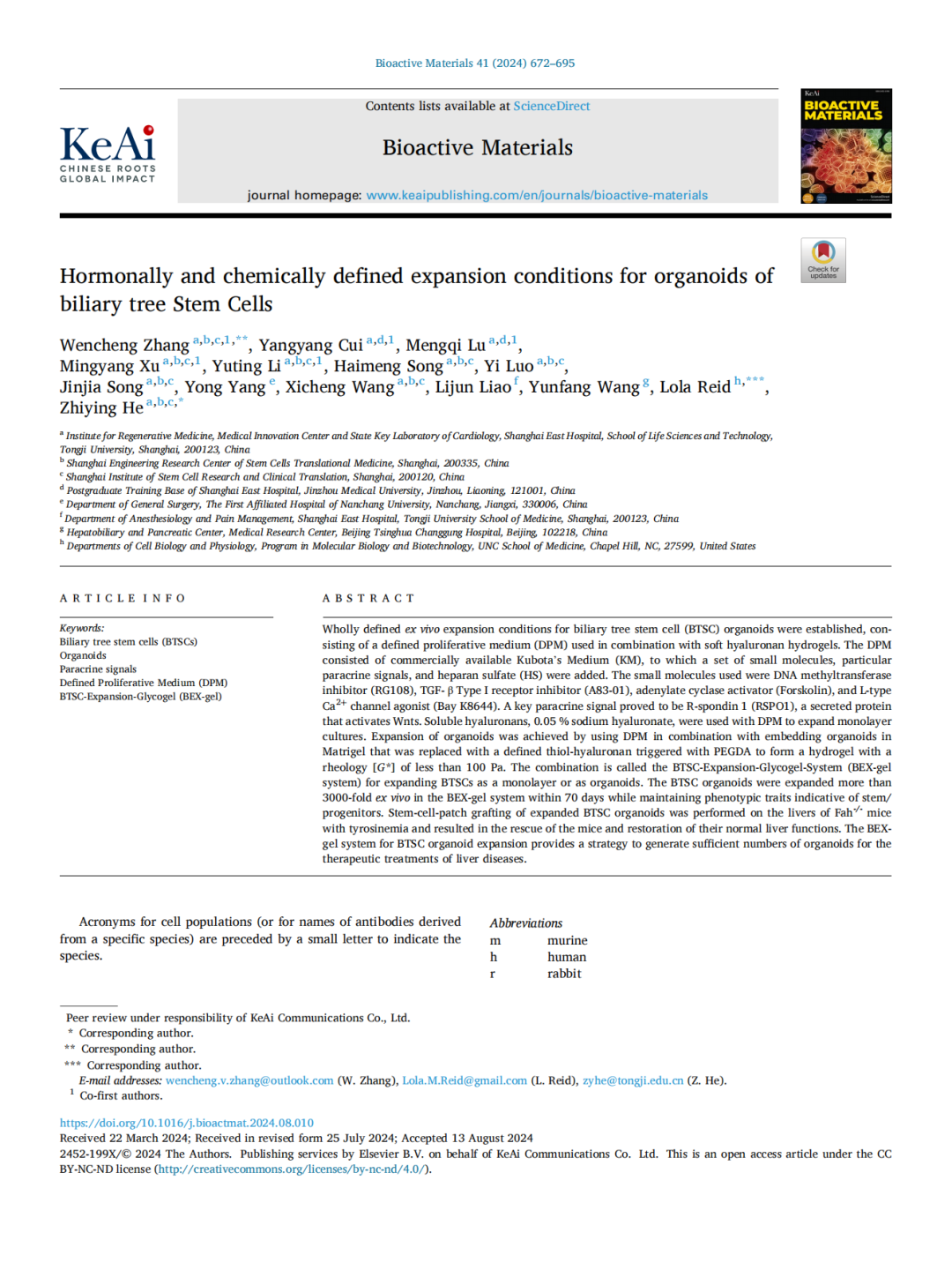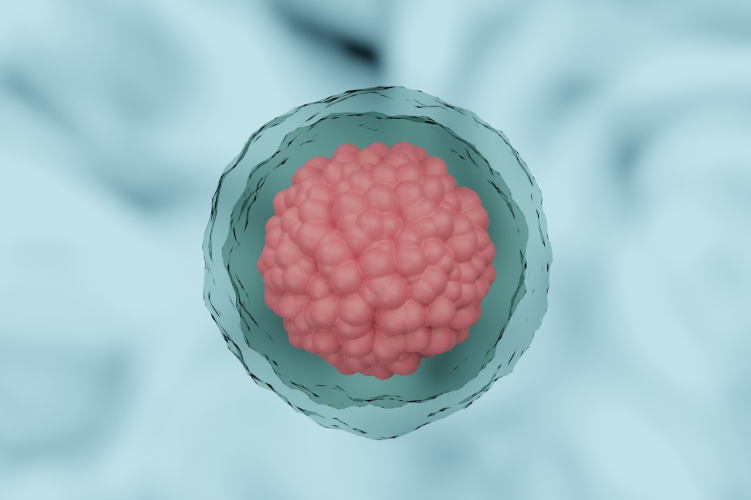
On September 11, 2024, the team of Professor He Zhiying and Associate Researcher Zhang Wencheng at the Institute of Regenerative Medicine of the Stem Cell Base of Shanghai City Oriental Hospital (Oriental Hospital Affiliated to Tongji University), the School of Life Science and Technology of Tongji University, and the team of Professor Lola Reid at the University of North Carolina at Chapel Hill (UNC-CH) published a research paper titled "Hormonally and Chemically Defined Expansion Conditions for Organoids of Biliary Tree StemCells" on Bioactive Materials.

The research team successfully built a precisely defined BTSC(biliary stem cell) organoid expansion system. The system determined the key microenvironmental factors required for BTSC organoid expansion through in-depth analysis, and developed a method based on this. A hydrogel expansion system called BEX(Biliary tree stem cell expansion hydrogel system). This system has allowed a thousand-fold increase in the number of BTSC and its derived organoids. These expanded BTSC and its organoids can not only differentiate into functional hepatocytes in vitro, but also effectively treat liver failure model mice in vivo through the stem cell patch transplantation technology previously developed by the research team. The establishment of this system provides a large number of fully functional stem cell resources for the application of BTSC in clinical treatment.
01 Human bile duct tree stem cells

Human biliary tree stem cells (BTSC) are liver/pancreatic co-progenitor stem cells located in stem cell niches in peribiliary tree glands (PBG) within the intrahepatic, extrapancreatic and extrapancreatic bile duct tree walls.
During organ development and regeneration, BTSC has the ability to differentiate into multiple stem cell subsets. On the one hand, they can differentiate into hepatic stem cells (HpSC) and their descendants hepatoblasts (HBs) located in or near the Hering canal, thereby participating in the liver regeneration process. On the other hand, BTSC can also participate in pancreatic regeneration by differentiating into pancreatic stem cells located in PBG in the common liver/pancreatic duct. These characteristics give BTSC important potential in clinical applications, providing a new treatment strategy for the repair of liver and pancreatic functional damage.
02 Research steps

By comparing the transcriptome maps of BTSC and mature hepatic parenchymal cells, the research team accurately identified key signaling pathways that maintain BTSC dryness, including Hippo, PI3K/AKT, MAPK and Ras.
Combined with previous studies on embryonic stem cells (ESC) and endodermal stem cells derived from gastric epithelial cells, the researchers screened a series of small molecule compounds, such as 0.5μM Bix01294, 2μM Bay K8644, 0.04μM RG108, 2μM SB431542, 10μM forskolin and 1μM A83-01, as well as growth factors or paracrine signals such as 50 ng/mL EGF, 100 ng/mL R-Spondin1 (RSPO1), 100 ng/mL Noggin and 50 ng/mL Wnt3a, etc., together constitute 10-Defined-Proliferation-Medium (10-DPM). This medium successfully achieved the expansion of primary BTSC, expanding 20 times within 7 days. Further studies have shown that 10-DPM can not only effectively maintain the passage and amplification of BTSC, but also obtain BTSC organoids and achieve long-term amplification and passage in a three-dimensional amplification system combined with hydrogels (such as Matrigel or hyaluronate-heparin hydrogels).

RG108, A8301, Forskolin, BAY 8644 are critical to the expansion of mBTSC
In a combination optimization and screening study of 10-DPM, the results confirmed that among all small molecule compounds, 4-DPM composed of DNA methylase inhibitor RG108, TGFβ signaling pathway inhibitor A83-01, cAMP agonist forskolin, and calcium ion channel agonist Bay K8644 is an essential component for primary BTSC amplification. However, in the absence of RSPO1, the activating ligand of the Wnt signaling pathway, the passage and organoid formation of BTSC and the ability to continue passage are significantly affected. The 5-DPM formed after supplementation with RSPO1 has comparable ability to 10-DPM in promoting the proliferation of primary BTSC, two-dimensional expansion of BTSC, and the formation and long-term expansion maintenance of BTSC organoids, thus confirming the key role of the Wnt signaling pathway in BTSC expansion and BTSC organoid formation.
Compared with traditional two-dimensional culture conditions, hydrogel-based three-dimensional amplification systems show significant advantages. Under the conditions of 5-DPM as the amplification medium, the two-dimensional hydrogel pretreatment system can only maintain the properties of BTSCs for a limited number of generations. Relatively speaking, BTSC organoids can be stably passaged for more than 20 generations under 5-DPM conditions and achieve more than 3000-fold cell expansion within 60 days. In addition, by comparing the transcriptome profile analysis of BTSCs amplified under two-dimensional and three-dimensional conditions, it was found that the three-dimensional amplification system could significantly reduce the DNA damage generated during cell proliferation, providing cells with damage protection that two-dimensional monolayer culture lacked. These results emphasize the importance of three-dimensional culture systems in maintaining BTSCs expansion and function.
After confirming the medium, the study further optimized the composition of the hydrogel. Similar to other three-dimensional culture and expansion studies, the study first drew on the Matrigel-based organoid formation and maintenance system of Hans Clevers and others. Matrigel(Corning) is mainly composed of four main basement membrane components, including laminin (about 60%), type IV collagen (about 30%), nestin (about 8%) and heparan sulfate proteoglycans (HSPGs), especially beaded proteins (about 2 - 3%). The biological activities of other components have been extensively studied, but their glycosaminoglycans independent of proteoglycans have not yet been determined. Matrigel was successfully replaced by combining the glycosaminoglycan components in the microenvironment of BTSC and adding heparan sulfate and its proteoglycan components (HAHS) to the hyaluronic acid hydrogel. It was finally combined with 5-DPM to form a BEX system with defined composition of BTSC organoid in vitro amplification.

Maintaining as an organoid (3D) better improves the resistance of mBTSC to DNA damage compared to monolayer (2D) culture
This study successfully established the BEX system and achieved large-scale expansion of BTSC and its organoids in vitro. The expanded BTSC not only maintained the potential for liver differentiation, but also demonstrated the ability to treat liver failure in animal models. This work provides a stable and efficient seed cell preparation system for clinical transformation applications based on BTSC transplantation in the treatment of liver failure, solves key issues of BTSC acquisition and expansion, and provides strong support for clinical treatment.